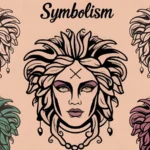Medusa tattoos are more than just striking designs—they’re powerful symbols of strength, transformation, and resilience rooted in ancient Greek mythology.
Whether you’re drawn to Medusa’s fierce gaze, her serpentine hair, or her complex story, a Medusa tattoo can be a deeply personal way to express your journey.
This guide explores the meanings behind Medusa tattoos, their cultural significance, and practical tips for choosing a design that resonates with you.
From empowerment to protection, we’ll help you understand why Medusa is a timeless choice and how to make your tattoo uniquely yours.
Why Choose a Medusa Tattoo? A Quick Overview
Before diving into the details, here’s a snapshot of the most common meanings behind Medusa tattoos, tailored for those considering this design:
| Meaning | Why It Resonates | Design Ideas |
|---|---|---|
| Empowerment | Reclaiming strength after trauma or injustice | Medusa’s face with bold eyes and flowing snakes |
| Protection | Warding off negativity or harm | Gorgoneion (Medusa’s head) or a shield motif |
| Transformation | Embracing change or personal growth | Snakes intertwined with flowers or vines |
| Feminine Rage | Channeling anger against oppression | Fierce expression with sharp, coiling snakes |
| Beauty & Danger | Celebrating duality and complexity | Soft features paired with menacing snakes |
| Resilience | Overcoming adversity | Severed head with a serene or defiant look |
This table is your starting point. As you read on, you’ll discover how to personalize these meanings and bring your vision to life.
The Mythological Origins of Medusa
Medusa’s story is the heart of her tattoo’s allure. In Greek mythology, she was one of three Gorgons—monstrous sisters with snakes for hair and a gaze that turned people to stone. Unlike her immortal sisters, Stheno and Euryale, Medusa was mortal, adding tragedy to her tale.
According to Ovid’s Metamorphoses, Medusa was once a beautiful priestess in Athena’s temple. Her beauty drew the attention of Poseidon, who assaulted her in the sacred space. Athena, enraged by the violation, punished Medusa by transforming her into a gorgon with serpentine hair and a petrifying stare.
Later, the hero Perseus beheaded Medusa using a mirrored shield to avoid her gaze. From her neck sprang Pegasus and Chrysaor, symbolizing creation born from destruction.
This narrative of beauty, betrayal, and transformation makes Medusa a compelling figure for tattoos, embodying both victimhood and power.
Core Symbolism of Medusa Tattoos
Medusa tattoos carry layered meanings that resonate with diverse individuals. Here’s a closer look at the primary symbols and how they might speak to you:
1. Empowerment and Reclaiming Power
For many, Medusa represents reclaiming strength after trauma or injustice. Her transformation into a monster can be seen as a feminist allegory—a woman punished for others’ actions yet emerging as a force to be reckoned with.
A Medusa tattoo might symbolize taking back your narrative, especially for survivors of abuse or societal judgment.
Example: Sarah, a 28-year-old teacher, chose a Medusa tattoo after overcoming an abusive relationship. “Her snakes remind me that I can be fierce and protect myself,” she says. Her design features Medusa’s face with piercing eyes, symbolizing her newfound confidence.
2. Protection and Warding Off Evil
In ancient Greece, Medusa’s head (Gorgoneion) was a protective talisman, used on shields and temples to repel evil. A Medusa tattoo can serve as a personal shield, guarding against negativity, betrayal, or harm. It’s a popular choice for those who want to project strength and deter ill intentions.
Design Tip: Consider a Gorgoneion with sharp, angular snakes for a bold protective vibe, or pair it with a shield for added symbolism.
3. Transformation and Duality
Medusa’s shift from maiden to monster embodies transformation and the coexistence of beauty and horror. A tattoo might reflect your own journey of growth, embracing both your light and shadow selves. It’s ideal for those who’ve navigated significant life changes.
Example: Alex, a 35-year-old artist, got a Medusa tattoo after a career pivot. “Her snakes winding into flowers show how I turned chaos into creativity,” they explain.
4. Feminine Rage and Power
Medusa’s fierce form channels raw, unapologetic feminine rage—a defiance of patriarchal norms. A tattoo can celebrate this strength, reminding you to stand tall against oppression. It’s a bold statement for feminists and activists.
Design Tip: Emphasize Medusa’s intense gaze or sharp snakes to capture her fiery spirit.
5. Beauty and Danger
Medusa’s allure lies in her duality—stunning yet deadly. A tattoo can reflect your multifaceted nature, blending charm with strength. This resonates with those who embrace their complexity.
6. Survivor’s Resilience
Medusa’s enduring legacy, despite her hardships, makes her a symbol of resilience. A tattoo can honor your ability to rise above adversity, whether it’s trauma, loss, or judgment.
What It Says About You: A Medusa tattoo might say, “I’ve faced my struggles and come out stronger.” It’s a badge of courage and defiance.
How to Personalize Your Medusa Tattoo
Choosing a Medusa tattoo is a personal journey. Here’s how to tailor your design to reflect your story:
- Match the Meaning to the Design:
- Empowerment: Focus on Medusa’s face with a confident expression or raised chin.
- Protection: Incorporate a shield, mirror, or Gorgoneion for a talismanic effect.
- Transformation: Blend snakes with symbols of growth, like vines, roses, or butterflies.
- Rage: Highlight sharp, dynamic snakes or a fierce, snarling Medusa.
- Duality: Pair soft, feminine features with menacing elements, like coiling snakes or a subtle smirk.
- Choose the Right Style:
- Realism: Lifelike details for a dramatic, emotional impact. Ideal for large pieces on the back or chest.
- Neo-Traditional: Vibrant colors and bold lines with a whimsical twist. Great for arms or thighs.
- Blackwork: Stark, graphic designs using heavy black ink. Perfect for a bold, minimalist look.
- Minimalist: Simple lines or small symbols (e.g., a single snake or Medusa’s eye) for wrists or ankles.
- Surrealist: Abstract or dreamlike elements for a unique, artistic take.
- Incorporate Personal Elements:
- Add symbols that reflect your story, like a phoenix for rebirth or a heart for love.
- Include dates, initials, or quotes in subtle script to honor a specific moment or person.
- Use colors that resonate with you (e.g., red for passion, blue for calm).
- Work with Your Artist:
- Share your story and desired meaning to guide the design.
- Ask about their experience with your chosen style (e.g., realism requires strong shading skills).
- Request a sketch or digital mock-up to visualize the tattoo on your body.
- Consider Placement and Pain:
- Back/Chest: Best for large, detailed designs but can be painful due to thin skin.
- Arm/Thigh: Versatile for medium designs, with moderate pain.
- Wrist/Ankle: Ideal for small, minimalist tattoos; pain varies but can be sharp.
- Neck/Behind Ear: Bold and intimate, with higher pain due to sensitivity.
Pro Tip: Search Instagram hashtags like #MedusaTattoo or Pinterest boards for inspiration. Save a few designs to show your artist, but let them adapt the concept to your body and style.
Cultural and Historical Context
Medusa’s image has evolved over centuries, shaping her modern appeal. In ancient Greece, her Gorgoneion adorned armor and temples as a protective symbol, initially grotesque but later softened to highlight her beauty.
During the Renaissance, artists like Caravaggio portrayed her as tragic yet captivating, blending horror with humanity. Today, Medusa is a feminist icon, reclaimed as a symbol of resistance in art, fashion (e.g., Versace’s Medusa logo), and media.
This cultural shift makes Medusa tattoos especially relevant for those who see her as a misunderstood figure, embodying strength through adversity.
Artistic Representations of Medusa Tattoos
Medusa tattoos are incredibly versatile. Here are some iconic design ideas to spark your creativity:
- Classic Realism: A detailed Medusa face with piercing eyes, flowing snakes, and subtle shading. Perfect for a bold chest piece.
- Neo-Traditional Gorgoneion: A stylized Medusa head with vibrant greens and golds, accented by roses. Great for an arm sleeve.
- Minimalist Snake: A single, coiling snake with Medusa’s eye at its center. Discreet for a wrist or ankle.
- Surrealist Fusion: Medusa’s face merging with a mirror or galaxy, symbolizing reflection and infinity. Ideal for a unique thigh design.
- Blackwork Severed Head: Perseus holding Medusa’s head in stark black ink, emphasizing triumph. Striking on the upper arm.
Common Elements:
- Snakes: Writhing, scaled, or adorned with eyes for intensity.
- Eyes: Piercing or glowing to capture her deadly gaze.
- Mirrors/Shields: Symbolizing protection or self-reflection.
- Floral Accents: Roses or vines to soften the design and highlight beauty.
Where to Find Inspiration: Check out #MedusaTattoo on Instagram or Pinterest for thousands of designs. Tattoo parlors often have portfolios online, too.
Who Chooses Medusa Tattoos?
Medusa tattoos appeal to a wide audience:
- Survivors: Those who’ve overcome trauma or abuse, like Sarah, see Medusa as a symbol of resilience.
- Feminists: Activists embrace her as a figure of feminine power and rage.
- Mythology Fans: Lovers of Greek stories are drawn to her historical depth.
- Creatives: Artists and free spirits love her visual versatility.
- Protectors: Those seeking a talisman against negativity choose her for her apotropaic roots.
What Your Tattoo Says: It might say, “I’m strong, complex, and unafraid to be both beautiful and fierce.”
Practical Considerations for Your Tattoo
Getting a Medusa tattoo is a commitment. Here’s how to plan:
- Research Artists: Look for someone skilled in your style (e.g., realism, blackwork). Check their portfolio on Instagram or their website.
- Budget: Prices vary ($100-$500+ depending on size and detail). Discuss costs upfront.
- Pain Management: Bring water, snacks, and headphones for long sessions. Ask about numbing cream if needed.
- Aftercare: Follow your artist’s advice (e.g., keep it clean, avoid sun exposure) to ensure proper healing.
- Questions to Ask:
- How will the design look on my body?
- Can you customize it to reflect my story?
- What’s the estimated time and cost?
Medusa Tattoos in Popular Culture
Medusa’s influence spans fashion, music, and media:
- Versace: The brand’s Medusa logo symbolizes luxury and power.
- Music: Artists like Rihanna reference Medusa’s fierce energy.
- Film/Literature: Modern retellings portray her as a misunderstood heroine, fueling her feminist appeal.
Social media platforms like Instagram showcase stunning Medusa tattoos, making her a trending choice.
Addressing Controversies
Some criticize Medusa tattoos for perpetuating stereotypes of women as vengeful or dangerous. Others argue her story is too tied to victim-blaming. However, many wearers see her as a symbol of empowerment, reinterpreting her myth to celebrate resilience and agency. Your tattoo’s meaning is yours to define.
Conclusion
A Medusa tattoo is a powerful statement of strength, transformation, and resilience. Whether you’re drawn to her as a survivor, protector, or embodiment of duality, her image offers endless possibilities for self-expression.
By understanding her meanings, exploring design options, and working with a skilled artist, you can create a tattoo that tells your story.
Search #MedusaTattoo for inspiration, reflect on what she means to you, and take the first step toward your ink journey with confidence.











